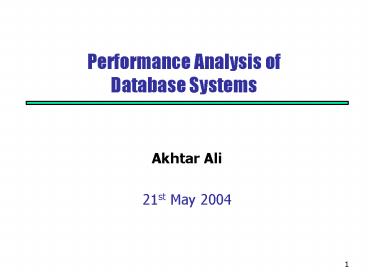Performance Analysis of Database Systems - PowerPoint PPT Presentation
1 / 11
Title:
Performance Analysis of Database Systems
Description:
Compared and contrasted elapsed time of executing queries/traversals against both DBs. ... Then estimated the elapsed time for the entire dataset. ... – PowerPoint PPT presentation
Number of Views:58
Avg rating:3.0/5.0
Title: Performance Analysis of Database Systems
1
Performance Analysis of Database Systems
- Akhtar Ali
- 21st May 2004
2
Motivations
- There is a current interest in comparing and
contrasting different database - Systems
- Data Models and
- Design considerations
- Several benchmarks have been developed
- OO7, TPC, BUCKY
- Support for systems comparison rather
models/design - In order to choose which database system to use,
we need to be aware of (beside other issues)
performance based comparison across the board. - Relational vs. Object-Relational vs.
Object-Oriented
3
Our Approach
- Comparison based on different data models and
design alternatives rather than system A vs. B - Database systems often have different
configurations, algorithms, buffering techniques,
block size etc - Comparing system A against B involves several
variables - Difficult to isolate the impact of how the
database is structured - Using uniform experimental environment
- Using Oracle 9i for relational vs.
object-relational - Using Lambda-DB for relational vs.
object-oriented - Object-relational vs. object-oriented (not yet)
4
Relational vs. Object-Relational DBs
- Used the OO7 benchmark
- Implemented the OO7 database schema using Oracle
9i - Relational SQL (tables)
- Object-Relational SQL (object types, object
tables, references etc) - Implemented queries/traversals from the OO7
benchmark on both DBs. - Compared and contrasted elapsed time of executing
queries/traversals against both DBs. - Results are consistent with BUCKY ACM SIGMOD
1997, which was implemented over Informix
Universal Server. - But against our expectations
- Relational database outperforms its
object-relational counterpart.
5
OO7 Benchmark Schema
6
Results (I)
- Traversals
- T1 Traverse the assembly hierarchy. As each base
assembly is visited, visit each of its referenced
unshared composite parts. As each composite part
is visited, perform a depth first search on its
graph of atomic parts. Return a count of the
number of atomic parts visited when done. - Read-only traversal (T1, T6) T6 is a variant of
T1. - Simple update traversal (T2A, T2B, T2C)
- 1 or 20 or 4 x 20 objects are updates per
iteration - Index update traversal (T3A, T3B, T3C)
- Queries
- Single level query (Q5) Base Assemblies
- Ad-hoc join query (Q8) Documents and Atomic Parts
7
Results (I)
8
Relational vs. Object-Oriented DBs
- Based on the assumption
- An Object DBMS can implement a relational design
(analogous to writing C style programmes using
C compiler) - Implemented the OO7 database schema using
Lambda-DB, an OODBMS - Realizing a relational design using ODL and OQL
- Mapping the UML schema directly using ODL and OQL
- Implemented few traversals from the OO7 benchmark
on both DBs. - Compared and contrasted elapsed time of executing
traversals against both DBs. - Results are according to our expectations
- OO outperforms Relational by 45 to 3 times.
9
Results (II)
- To our astonishment T1 took 15 days, 15 hours
and 34 minutes to complete over the relational
database - Of course we did not run T1 for 15 days.
- Actually we aborted the program several times and
executed it for a smaller dataset. - Then estimated the elapsed time for the entire
dataset. - We realized that indexes were not created on
foreign keys - The same query took about 10 minutes.
- The re-confirms the importance of basic query
optimization principles.
10
Results (II)
11
Conclusions
- Relational vs. Object-Relational
- RDBs have overcome some of the performance issues
by clever optimization techniques. - ORDBs are predominantly relying on the relational
core. - For example, Oracle implements nested tables with
explicit storage outside the containing objects. - Requires expensive unnesting and pointer
de-referencing. - ORDBs may need to stand on their own footing
rather than on their predecessors - RDBs.
- Relational vs. Object-Oriented
- Use of indexes on foreign keys makes a big
difference in RDBs. - One of the main reason behind OODBs performance
is that relationships are persistent. - Objects are stored as if they are in an
object-network rather than scattering them in
several tables. - RDBs have to re-construct the object-network in
order to support the applications demands.































